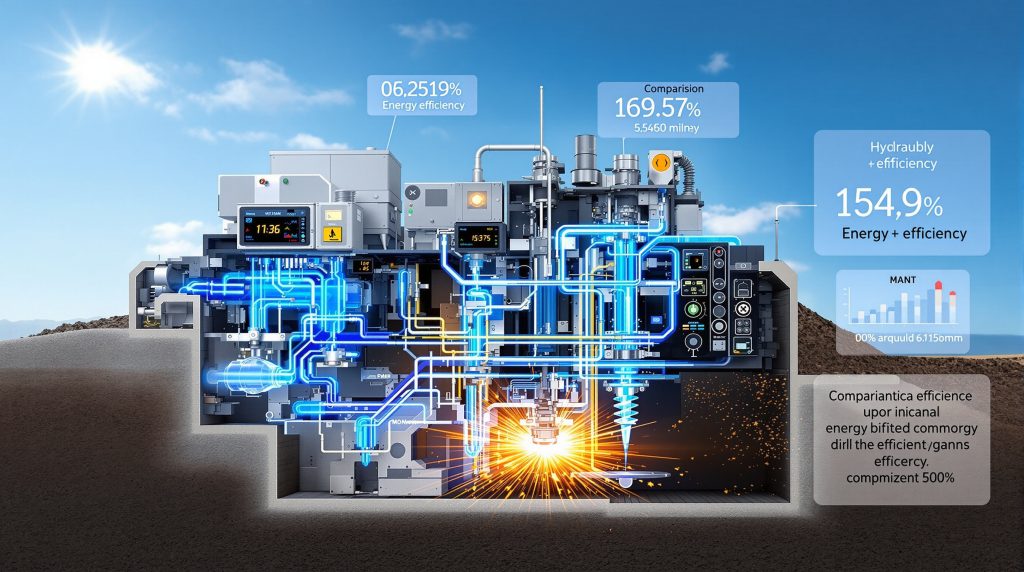Revolutionizing Drilling Operations: The Impact of Hybrid Impact Technology
Drilling operations across mining, construction, and energy sectors are experiencing a significant transformation through the innovative application of Hybrid Impact Technology (HIT). This groundbreaking approach represents one of the most important advancements in drilling methodology in decades, particularly for down-the-hole (DTH) applications where efficiency and performance are paramount.
The Evolution of Drilling Technology
Traditional drilling systems have dominated industrial applications for generations, with pneumatic DTH and rotary drilling being the primary methods employed across various sectors. These conventional approaches, while effective, have long suffered from significant energy inefficiencies that impact operational costs, environmental footprints, and overall performance.
For decades, large-diameter blasthole drilling has relied predominantly on rotary tools or pneumatic DTH systems. According to industry reports from GeoDrilling International, both approaches experience substantial energy losses between the power source and the rock face, creating a persistent challenge for operators seeking more efficient solutions.
The drilling industry has continuously sought innovations to address these fundamental limitations, leading to the development of more sophisticated energy delivery mechanisms that maintain or enhance performance while reducing resource consumption. Furthermore, AI drilling innovations are increasingly complementing these mechanical advancements, creating a more comprehensive approach to operational efficiency.
Core Principles of Hybrid Impact Technology
Hybrid Impact Technology represents a paradigm shift in drilling operations by fundamentally reimagining how energy is delivered to drilling bits. The core innovation replaces compressed air with hydraulic energy as the primary power source, creating a more direct and efficient energy transfer pathway.
The technology transfers power to the drilling bit more directly with substantially reduced energy loss compared to conventional systems. This approach minimizes the efficiency gaps that have long plagued traditional drilling methods while maintaining or improving operational effectiveness.
By creating more efficient power transmission chains, HIT addresses long-standing challenges in drilling operations while opening new possibilities for applications where conventional systems struggle to deliver optimal performance. These developments align with broader industry innovation trends that focus on resource efficiency and performance optimization.
How Hybrid Impact Technology Works
The fundamental innovation behind Hybrid Impact Technology lies in its energy transfer mechanism, which completely rethinks traditional down-the-hole drilling principles to overcome inherent inefficiencies.
Technical Framework and Components
HIT systems typically incorporate several integrated components working together to deliver enhanced drilling performance:
- Surface hydraulic power generation units that create the initial energy
- Specialized fluid delivery systems designed to transfer hydraulic energy downhole with minimal losses
- Proprietary impact mechanisms that efficiently convert hydraulic energy into mechanical force
- Advanced bit designs specifically optimized for hybrid power delivery
- Integrated control systems that provide real-time monitoring and performance adjustment capabilities
This integrated approach creates a more coherent energy pathway from generation to application, addressing multiple points where traditional systems experience efficiency losses.
Energy Transfer Efficiency
The core advantage of HIT systems stems from their more efficient energy transfer characteristics:
- Direct hydraulic power transmission substantially reduces the energy losses inherent in pneumatic systems
- Reduced friction and heat generation throughout the power delivery chain
- Minimized energy dissipation between the power source and rock face
- More consistent power delivery regardless of drilling depth
- Optimized energy utilization across the entire drilling operation
These efficiency improvements translate directly into operational benefits, particularly in challenging drilling environments where conventional systems struggle to maintain performance. The technology's approach aligns with data-driven mining principles that emphasize resource optimization and performance monitoring.
Performance Characteristics
HIT systems demonstrate several performance advantages compared to traditional drilling methods:
- Comparable or superior penetration rates to conventional systems in most formations
- More precise control over impact force and frequency
- Enhanced operational stability during drilling
- Reduced vibration and equipment stress
- More consistent performance across varying geological conditions
These performance characteristics make HIT particularly valuable in applications requiring precision, reliability, and efficiency across diverse drilling environments. According to hybrid technology impact studies, such performance improvements are critical for next-generation industrial applications.
Key Benefits of Hybrid Impact Technology
The implementation of HIT delivers multiple advantages addressing critical challenges facing drilling operations across various sectors, from mining to construction and beyond.
Operational Efficiency Improvements
HIT offers substantial operational improvements that directly impact productivity and resource utilization:
- Energy consumption reduction: While specific figures vary by implementation, hydraulic systems typically demonstrate 30-50% lower energy requirements compared to pneumatic alternatives for equivalent work output
- Decreased fuel requirements: Lower energy consumption translates directly to reduced fuel needs for power generation
- Reduced maintenance requirements: Less system stress and more controlled operation typically extend component lifecycles
- Extended equipment lifespan: Optimized energy management reduces wear on critical components
- Enhanced drilling rates: More efficient power delivery can improve penetration rates in certain formations
These efficiency gains provide both immediate operational benefits and long-term advantages through reduced lifecycle costs and improved equipment utilization.
Environmental Impact Reduction
HIT contributes to sustainability goals through several environmental advantages:
- Decreased carbon emissions resulting from lower fuel consumption
- Reduced noise pollution compared to compressed air systems, which typically operate at higher decibel levels
- Minimized dust generation during operations, improving air quality around drilling sites
- Potential for reduced water usage in certain applications
- Smaller operational footprint for equivalent drilling capacity
As industries face increasing pressure to reduce environmental impacts, these benefits position HIT as a forward-looking technology aligned with sustainable mining transformation objectives that are becoming increasingly important in the resources sector.
Economic Advantages
The economic case for HIT stems from multiple factors affecting both operational costs and revenue potential:
- Reduced operational expenses through significant fuel savings over equipment lifetime
- Lower maintenance costs from extended component lifecycles and reduced system stress
- Potential productivity increases from improved drilling rates and reduced downtime
- Enhanced project economics, particularly for large-scale operations where efficiency gains scale significantly
- Competitive differentiation through advanced technology adoption
While initial investment costs may be higher than conventional systems, the total cost of ownership analysis typically demonstrates compelling economic benefits, particularly for high-utilization operations.
HIT Compared to Traditional Drilling Technologies
Understanding the relative advantages and limitations of Hybrid Impact Technology requires direct comparison with established drilling methods across various performance metrics.
HIT vs. Pneumatic DTH Systems
| Factor | Pneumatic DTH | Hybrid Impact Technology |
|---|---|---|
| Energy Source | Compressed air | Hydraulic power |
| Energy Efficiency | Lower (significant losses) | Higher (direct transfer) |
| Operational Cost | Higher fuel consumption | Reduced fuel requirements |
| Depth Limitations | Performance decreases with depth | More consistent at varying depths |
| Environmental Impact | Higher emissions and noise | Reduced emissions and noise |
| Maintenance Requirements | More frequent service intervals | Extended service intervals |
| Initial Investment | Lower equipment cost | Higher technology investment |
| Operational Noise | Higher decibel levels | Reduced noise pollution |
| Dust Generation | Higher particulate generation | Reduced dust production |
The comparative advantages of HIT become most pronounced in applications where efficiency, environmental considerations, and consistent performance across varying conditions are prioritized.
HIT vs. Rotary Drilling
| Factor | Rotary Drilling | Hybrid Impact Technology |
|---|---|---|
| Mechanism | Continuous rotation and pressure | Controlled impact force |
| Formation Suitability | Most effective in softer formations | Versatile across formation types |
| Bit Wear | Variable depending on formation | More consistent wear patterns |
| Energy Consumption | High in hard formations | More efficient in hard formations |
| Penetration Rate | Slower in harder materials | Maintains rate across various hardnesses |
| Initial Investment | Lower equipment cost | Higher technology investment |
| Precision Control | Limited force adjustment | More precise impact control |
| Vibration | Higher in certain formations | Reduced operational vibration |
| Adaptability | Formation-specific optimization required | More versatile across conditions |
These comparisons highlight the contextual nature of drilling technology selection, with HIT offering particular advantages in challenging environments and applications where efficiency and consistent performance are critical considerations.
Applications Benefiting Most from Hybrid Impact Technology
HIT offers particular advantages in specific drilling scenarios and industries where efficiency and performance are critical factors for operational success.
Mining Applications
The mining sector presents numerous high-value applications for HIT implementation:
- Large-diameter blasthole drilling for open-pit operations: Enhanced efficiency in creating blast patterns for ore extraction
- Production drilling in underground mines: Improved performance in confined spaces with reduced emissions and noise
- Exploration drilling for resource definition: More consistent performance across varying geological formations
- Ventilation and service hole drilling: Precise control for critical infrastructure development
- Ground stabilization and reinforcement: Enhanced reliability for safety-critical applications
These mining applications benefit particularly from the reduced energy consumption and more consistent performance characteristics of HIT systems. Various drilling program types can leverage these advantages across different operational contexts.
Construction and Infrastructure
Construction projects can leverage HIT advantages for several specialized applications:
- Foundation drilling for large structures: Improved efficiency in creating structural supports
- Anchor and tie-back installation: Enhanced precision for stability-critical elements
- Tunnel boring and excavation support: Reduced emissions and improved performance in confined spaces
- Bridge pier installation: Consistent performance in varying geological conditions
- Retaining wall construction: Reliable performance for safety-critical structures
The construction sector benefits particularly from the environmental advantages of HIT, especially in urban environments where noise and emissions restrictions may apply.
Water Well and Geothermal
Water and geothermal applications involve specialized requirements that align with HIT capabilities:
- Deep water well installation: Consistent performance regardless of depth
- Geothermal heat exchange systems: Efficient drilling for renewable energy applications
- Aquifer access and development: Precise control for sensitive environmental contexts
- Groundwater monitoring wells: Reliable performance for environmental compliance
- Geothermal resource exploration: Adaptability across varying geological formations
These applications particularly benefit from the precision control and environmental advantages offered by hybrid systems.
Specialized Applications
Several niche applications demonstrate the versatility and value proposition of HIT:
- Hard rock environments where traditional methods struggle to maintain performance
- Remote locations where fuel efficiency represents a critical operational factor
- Environmentally sensitive areas requiring reduced emissions and noise
- Projects with strict noise limitations such as urban construction
- Applications requiring precise control over drilling parameters for optimal results
These specialized scenarios often represent the highest-value implementation opportunities for hybrid drilling technologies.
Challenges Facing Hybrid Impact Technology
Despite its advantages, HIT faces several implementation challenges that affect its adoption rate across various drilling sectors.
Technical Considerations
Several technical factors influence the adoption and implementation of HIT systems:
- Higher initial investment costs compared to conventional drilling systems
- Learning curve for operators familiar with traditional technologies
- Integration challenges with existing equipment fleets and workflows
- Specialized maintenance requirements and technical expertise
- System optimization needs for different geological conditions
These technical considerations represent important factors in technology adoption decisions, particularly for organizations with established equipment fleets and operational protocols.
Industry Adoption Barriers
Broader industry factors also influence the implementation timeline for HIT:
- Conservative approaches to new technologies in drilling sectors with established practices
- Existing infrastructure supporting conventional drilling methods
- Training requirements for technical personnel across organizations
- Supply chain development needs for specialized components
- Industry standards and certification processes still evolving for newer technologies
These adoption barriers are typical for disruptive technologies entering established industrial sectors, requiring coordinated efforts between technology developers, equipment manufacturers, and end users.
Future Development Needs
Several development areas will influence the long-term adoption trajectory of HIT:
- Further miniaturization for smaller-scale drilling applications
- Enhanced automation and remote operation capabilities
- Broader range of specialized bit designs for different applications
- Integration with digital drilling and monitoring systems
- Adaptation for extreme environment applications
Addressing these development needs will expand the application range and value proposition of hybrid drilling technologies, potentially accelerating adoption across various sectors.
Current Implementation of Hybrid Impact Technology
The practical implementation of HIT is already underway, with several key players leading adoption across different sectors and applications.
Market Deployment Status
Current market activities show a strategic approach to technology introduction:
- Initial focus on large-diameter mining applications where efficiency benefits scale significantly
- Strategic partnerships between technology developers and drilling contractors to facilitate field testing
- Phased implementation starting with high-value applications demonstrating clear ROI
- Demonstration projects showcasing real-world performance in various conditions
- Performance monitoring and case study development to support broader adoption
This methodical market approach reflects the significant investment required for new drilling technology implementation and the importance of demonstrated performance for industry acceptance.
Industry Collaboration Initiatives
Several collaborative efforts are supporting technology advancement:
- Joint development initiatives between equipment manufacturers to address standardization
- Knowledge sharing through industry associations and technical forums
- Operator training programs and certification development
- Collaborative field testing across various operational environments
- Technical standards development for component compatibility and performance metrics
These collaborative initiatives are critical for addressing the ecosystem requirements of disruptive technology adoption in established industrial sectors.
Strategic Partnership Example: Mincon and Epiroc
A notable example of industry collaboration comes from the partnership between Mincon and Epiroc in developing hybrid impact technology solutions:
- Strategic collaboration combining specialized expertise in drilling technology and equipment manufacturing
- Focus on integrating hydraulic power systems with impact drilling mechanisms
- Development of specialized components optimized for system performance
- Field testing across various operational environments to validate performance
- Joint market development to accelerate technology adoption
This partnership, highlighted by GeoDrilling International, demonstrates the importance of combining complementary expertise to address the technical challenges of hybrid drilling implementation. Mincon's innovative approach to hybrid impact technology has been particularly influential in advancing the field.
Future Outlook for Hybrid Impact Technology
The evolution of HIT is likely to continue, with several emerging trends shaping its development trajectory and industry impact.
Technological Advancements on the Horizon
Several technological developments will likely influence future HIT implementations:
- Integration with automation and autonomous drilling systems for enhanced efficiency
- Advanced sensing and real-time performance optimization capabilities
- Development of hybrid systems combining multiple energy sources for specific applications
- Advanced materials implementation for improved component durability
- Digital twins for predictive maintenance and performance modeling
These technological advances will further enhance the value proposition of hybrid drilling systems, particularly as digital transformation continues across industrial sectors.
Expanding Application Potential
Future applications will likely expand beyond current implementations:
- Adaptation for smaller-scale drilling operations through miniaturization
- Specialized versions for extreme environment drilling, including arctic and high-altitude applications
- Integration with directional drilling technologies for enhanced precision
- Potential applications in space and planetary exploration
- Development for underwater and subsea drilling applications
This expansion of application scope will create new market opportunities while addressing specialized drilling challenges in various sectors.
Industry Transformation Implications
The broader adoption of HIT will likely influence industry structures and practices:
- Evolving skill requirements for drilling personnel toward more technical expertise
- Changes in equipment fleet composition and management practices
- Evolution of drilling contractor business models incorporating technology advantages
- New service and support ecosystems for advanced drilling systems
- Potential for performance-based drilling contracts leveraging enhanced capabilities
These transformational impacts could reshape competitive dynamics in drilling-intensive industries as technology adoption accelerates.
Evaluation Framework for Drilling Operations
Organizations considering HIT implementation should follow a structured approach to assessment and adoption to maximize potential benefits while managing implementation risks.
Assessment Framework
A comprehensive evaluation process should include:
- Thorough analysis of current drilling efficiency metrics and operational costs
- Identification of specific operational challenges that HIT might address
- Calculation of potential return on investment across the equipment lifecycle
- Evaluation of environmental and regulatory benefits in specific operating contexts
- Assessment of implementation requirements including training and infrastructure
This structured assessment approach helps organizations quantify the potential value proposition of HIT for their specific operational context and constraints.
Implementation Strategy
A phased implementation approach typically includes:
- Pilot testing in representative operational environments to validate performance
- Staged deployment starting with highest-value applications demonstrating clear ROI
- Comprehensive training program development for operators and maintenance personnel
- Performance monitoring and continuous improvement processes
- Integration with existing equipment management systems and workflows
This methodical implementation strategy minimizes disruption while allowing organizations to capture learning and optimize deployment approaches.
Success Metrics
Key performance indicators for HIT implementation typically include:
- Energy consumption reduction measured in fuel usage per meter drilled
- Productivity improvements quantified as meters drilled per shift
- Maintenance cost reduction tracked through parts and labor expenses over time
- Environmental impact metrics including emissions, noise, and waste
- Total cost of ownership comparison with conventional drilling systems
These metrics provide quantitative assessment of implementation success while supporting ongoing optimization and expansion decisions.
Frequently Asked Questions About Hybrid Impact Technology
Is HIT suitable for all drilling applications?
While HIT offers advantages across many drilling scenarios, it may not be optimal for all applications. The technology shows greatest benefit in medium to large diameter holes, harder formations, and operations where fuel efficiency is critical. Smaller drilling operations or those in very soft formations may see less dramatic advantages compared to conventional systems.
What modifications are needed to implement HIT on existing rigs?
Implementation typically requires hydraulic power system upgrades, specialized downhole components, and control system modifications. The extent of modifications depends on the existing rig configuration, with purpose-built systems offering optimal performance. Many manufacturers offer retrofit kits for compatible equipment, though comprehensive assessment of existing systems is essential for successful integration.
How does HIT affect drilling crew requirements?
Operators require specialized training to maximize HIT benefits, though the basic drilling principles remain similar. Maintenance personnel need additional training on hydraulic systems and the specialized components. Overall crew size typically remains unchanged, but skill requirements may shift toward hydraulic system expertise and more technical diagnostic capabilities.
What is the expected ROI timeline for HIT implementation?
Return on investment varies based on operation scale, fuel costs, and drilling conditions. Most operations report ROI periods of 12-24 months, primarily through fuel savings, increased productivity, and reduced maintenance costs. High-utilization operations in remote locations with higher fuel costs typically see faster returns compared to intermittent or low-utilization scenarios.
How does HIT perform in varying geological conditions?
HIT maintains more consistent performance across different formation types compared to conventional systems. It excels particularly in harder formations where traditional pneumatic systems struggle with depth limitations and energy losses. Performance optimization for specific formations can be achieved through bit selection and operating parameter adjustments, providing versatility across diverse drilling environments.
The Future of Drilling Technology
Hybrid Impact Technology represents a significant step forward in drilling technology evolution, addressing fundamental efficiency challenges that have persisted for decades. As the technology matures and implementation experience grows, we can expect continued refinement and expansion of applications across mining, construction, and energy sectors.
The ongoing development of complementary technologies, including automation, data analytics, and advanced materials, will likely enhance the value proposition of hybrid drilling systems while opening new application possibilities. Organizations that take a strategic approach to evaluation and implementation stand to gain significant competitive advantages through improved operational efficiency, reduced environmental impact, and enhanced drilling capabilities.
For industry professionals seeking to stay at the forefront of drilling technology advancements, maintaining awareness of hybrid impact technology developments represents an important component of technological competence and strategic planning.
Looking for the Next Major Mining Breakthrough?
Stay ahead of the market with Discovery Alert's proprietary Discovery IQ model that instantly notifies you about significant ASX mineral discoveries, turning complex data into actionable investment insights. Explore why historic discoveries can generate substantial returns by visiting Discovery Alert's dedicated discoveries page and begin your 30-day free trial today.




